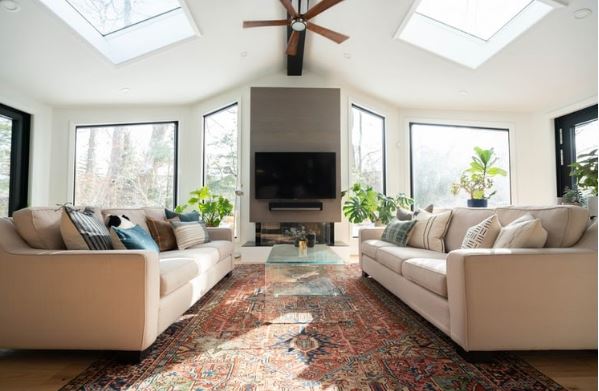 Building a home is an important goal for any family. Details of the exterior and the interior design are carefully planned and thought of. It’s not only important to sort out what kind of house you like, how many floors and rooms, what elements to be incorporated, and what features of convenience should be added.
Building a home is an important goal for any family. Details of the exterior and the interior design are carefully planned and thought of. It’s not only important to sort out what kind of house you like, how many floors and rooms, what elements to be incorporated, and what features of convenience should be added.
There are other more considerations to take note such as adding features that will maximize the space of your house and the installation of decorations and appliances that can add visual value, wellness, and health, and can save energy and consumption.
In choosing what to equip and install in your house, go for some things that have been proven to help houses in the past. Ceiling fans have been around for ages and that is only because they have become popular staples in modern family homes as they provide great aesthetics and science-proven functions efficient and sustainable for everyday home living.
Up and Above: What Are Ceiling Fans?
Ceiling fans could be installed in different areas of a home but they are most commonly found in the dining, living area and bedroom. They are mechanical things that are mounted on the ceiling together with the light fixtures. They are similar to the standing electric fans that are more commonly used in smaller sized homes or living quarters but they are installed permanently and usually only replaced when they are old and not working anymore.
The main function of a ceiling fan is to the circulation of air inside a room. They do not work like air-conditioning systems that produce cool air by reducing the temperature, they just work by producing movement causing a gentle breeze. They require less power and do not result in expensive electricity consumption but still works effectively for your summer day needs.
Although it does not work by cooling the air temperature, it can create a wind-chill effect which means it can affect the body by helping in sweat regulation. The same effect when you want to cool yourself by standing in front of a fan. Unlike air conditioning equipment that would require shut doors and closed windows to save energy and effectively manipulate the air, ceiling fans actually work better if these are open. It is effective for air circulation because it does not let it sit, especially warm air, in an area.
There is no stagnation of air even on windless days and it even escalates air movement on a breezy day for an even distribution across the room.
The Beauty Behind Windmill-Style Fans
If you are looking to add a ceiling fan to boost the functionality of your home while adding an aesthetic value then traditional ceiling fans may disappoint you. While they would function great anyhow, they wouldn’t fulfill the requirements because they regularly have 3 to 6 generic-looking blades.
They can look boring and out of place especially if you are keen on beautiful interior designs. This is why some modern homes forgo installing ceiling fans completely and resort to installing more air conditioning machines for their homes instead. That is a good decision but may not be ideal for your electricity bill at the end of the month.
Considering design is not only for which cabinets to buy or what color of wallpaper you should choose, but you should also be able to have a selection for aesthetically pleasing ones as well. Ceiling fans have evolved both ineffective functioning and visual design, you can check out windmill-style ceiling fans that incorporate the aesthetics while working the science of air cooling.
They have 10 or more blades which look impressive while balancing out natural airflow and your power consumption. They can blend in better with your other home decorations because of their unique style.
 The Different Parts
The Different Parts
Ceiling fans work like any other home appliances, they have a switch button to turn it on and other buttons for its speed. The most visible part of a fan is its blades. Bigger blades are designed to work efficiently in larger sized rooms. If you have a smaller one, you should choose a ceiling fan with smaller blades to make it energy-efficient.
They are usually made of wood, steel or even plastic. They are held in place by the blade iron which goes directly inside the motor. The motor is mechanically designed to be cost-efficient nowadays because of energy-saving features added while working quieter as well. An encasement that is decorative is used to house the motor. Moreover, there are ceiling fans with installed lamps in them. This is both for convenience and aesthetic purposes too.
Maintenance
Cleaning up your ceiling fan could pose to be a challenge as they are suspended in the air, way beyond your reach. Although you could always get a ladder and clean the fan yourself, it would be better to secure the help of professional cleaners. Their work is better in the long run because they have tools and materials for this. It would take a while to clean them up too especially if you have the windmill style ceiling fan for the blades are fragile and you could risk breaking them if you do it yourself.
How to Install
The Installation process for ceiling fans depends on the layout of your home. You should also be considering the height of your ceiling to know what type of ceiling fan to use. It would need professional installation because it needs to be connected to a power source and to be secured firmly above. The switch and control button should also be installed to operate the fan from below. The whole installation process wouldn’t take a long time if your place is already designed for it.
It is utterly important that you plan well how your home would work and look like. Ceiling fans could be beneficial for your everyday needs while helping you out in cutting back on expenses. Because of the availability of options for you, you could reap both the science working behind it and the aesthetics you need.
________________________________________________________
Interesting related article: “How to keep your home cool in summer and warm in winter.”

